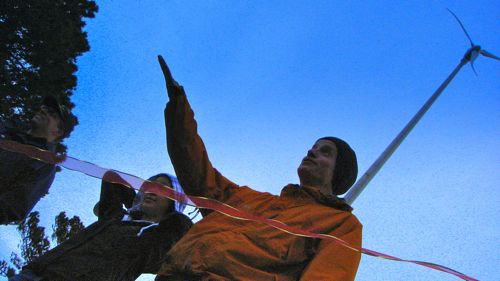
Mt. Edgecumbe science teacher Matt Hunter cuts the ribbon on the school’s full-size turbine in 2010. (KCAW photo/Robert Woolsey)
A researcher with the Alaska Center for Energy and Power in Fairbanks is visiting Sitka and Angoon this week (Apr 21 – 25) to test student-built wind turbines.
Chris Pike will be working with students studying turbine technology in a program called “KidWind,” a school curriculum originally funded by the National Renewable Energy Lab.
“The students design a wind turbine — just a mini-wind turbine about 2 feet in size. And they do things like design the blades for it, they design the gearing for it, the bases, and all this kind of stuff. And test it. Then we have a little contest where different schools from around the state can compare data with each other. We put them in front of a fan and measure how much power they produce. There’s a little generator in the back of them, and they can see the current coming out of it, the volts, and then the watts, which is what we use in our houses.”
Pike himself holds a master’s degree in renewable energy technology. He says KidWind is about more than building a machine, it’s about integrating systems. Wind power is variable, and really isn’t practical all by itself.
“When they watch how their wind turbine performs in front of the fan, you can really see how the power level is moving around a little bit. So you kind of get it in your head, Okay, I don’t want my lights flickering all the time in my house, or how is my computer going to work on that? So I think that gives them a real-life example of some of the challenges that we’re trying to face right now: integrating renewables into traditional systems. It’s not going to be an all-or-nothing game. We’re going to have to work together and integrate different types of systems.”
Pike says the coastal areas of Alaska are more promising for wind power than the interior of the state. Nevertheless, some of the first utility-grade wind turbines in Alaska have been installed at Eva Creek in Fairbanks. Running at peak, the Eva Creek turbines supply 20 megawatts of power, roughly the same as Sitka’s two hydro plants.
Pike says it takes a broad spectrum of interests and abilities to make alternative energy a reality in Alaska.
“And one of the neat things about some of the technologies is that it’s really interdisciplinary. So you might have a student that really loves a blade design, the physics, and maybe they’re going to go more into the science and engineering part of things. And you might have someone who is taking a look at the policy side of things, integrating renewables and the changing structure of utilities. And you might have someone else who is interested in the public relations side. So there are a lot of different things you can go into.”
During his swing through Southeast, Pike will test turbines in Matt Hunter’s class at Mt. Edgecumbe, and in Jim Parkins’ class in Angoon. Pike and the Alaska Center for Energy and Power are not Good Will Hunting with KidWind; rather than inspiring one or two brilliant students, they’re trying to lay down a new pattern for Alaskan energy for decades to come.
“And I don’t know about finding the next Thomas Edison of wind — I guess it’s a possibility. Having talent within Alaska, and building that education base for kids that are raised in the state is really important to building Alaska’s future, and keeping that talent within the state so we can really continue it as a form of economic development, and invest in our own future.”
Pike says there is no prize for the top turbine in the KidWind program. “Just knowing you’re the best,” he says.































